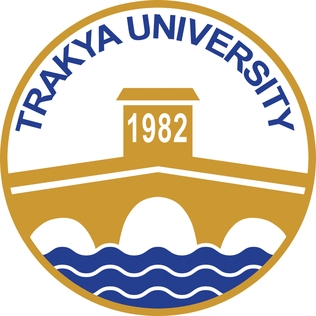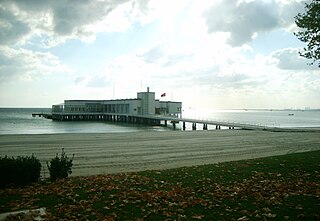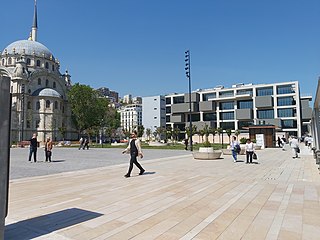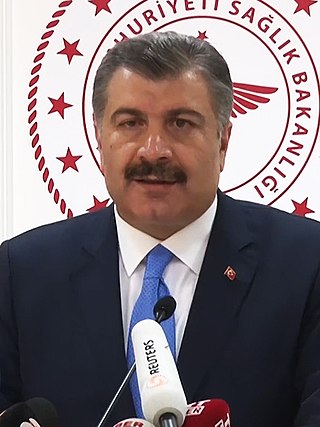
Beşiktaş is a district and municipality of Istanbul Province, Turkey. Its area is 18 km2, and its population is 175,190 (2022). It is located on the European shore of the Bosphorus strait. It is bordered on the north by Sarıyer and Şişli, on the west by Kağıthane and Şişli, on the south by Beyoğlu, and on the east by the Bosphorus. Directly across the Bosphorus is the district of Üsküdar.

Beyoğlu is a municipality and district of Istanbul Province, Turkey. Its area is 9 km2, and its population is 225,920 (2022). It is on the European side of İstanbul, Turkey, separated from the old city by the Golden Horn. It was known as the region of Pera surrounding the ancient coastal town Galata which faced Constantinople across the Horn. Beyoğlu continued to be named Pera during the Middle Ages and, in western languages, into the early 20th century.

Architecture of Turkey or Turkish architecture in the Republican Period is the architecture practised in Turkey since the foundation of the republic in 1923. In the first years of the republic, Turkish architecture was influenced by Seljuk and Ottoman architecture, in particular during the First National Architectural Movement. However, starting from the 1930s, architectural styles began to differ from traditional architecture, also as a result of an increasing number of foreign architects being invited to work in the country, mostly from Germany and Austria. The Second World War was a period of isolation, during which the Second National Architectural Movement emerged. Similar to Fascist architecture, the movement aimed to create a modern but nationalistic architecture.

The Turkish and Islamic Arts Museum is a museum located in Sultanahmet Square in Fatih district of Istanbul, Turkey. Constructed in 1524, the building was formerly the palace of Pargalı Ibrahim Pasha, who was the second grand vizier to Suleiman the Magnificent, and was once thought to have been the husband of the Sultan's sister, Hatice Sultan.

Trakya University, was established on July 20, 1982. The university is located in Edirne, at Turkey's European side. Trakya University is a regional university with institutions and schools spread over the Thrace region. Trakya University runs scientific activities related to regional development and has international relationships especially within the Balkan Universities Network including more than 40 Universities from Balkan countries and the University Loerrach in Germany. Erhan Tabakoglu was elected and confirmed as new Rector of the university in July 2016.

The Trabzon Museum, also known as Kostaki Mansion, is a historic house museum with archeological and ethnographic exhibitions located in Trabzon, Turkey.

The Istanbul Naval Museum is a national naval museum, located in the Beşiktaş district of Istanbul, Turkey. It was established in 1897 by the Ottoman Minister of the Navy Bozcaadalı Hasan Hüsnü Pasha.

Mehmet Vedat Tek (1873–1942) was a Turkish architect who was one of the leading figures of the First Turkish National Architectural Movement.

Florya Atatürk Marine Mansion, is a historic presidential residence located offshore in the Sea of Marmara in the Florya neighborhood of the Bakırköy district in Istanbul, Turkey.

The Istanbul Postal Museum, aka PTT Museum Istanbul, is a postal museum dedicated to the historical development of mail and telecommunication services in the Ottoman Empire and Turkey, exhibiting related equipment and instruments as well as a collection of postage stamps. It was established in 2000 by the Turkish Post, and is situated inside the Grand Post Office building at Sirkeci quarter of Fatih district in Istanbul, Turkey.

The Ibrahim Pasha Palace is an Ottoman imperial court residence of Pargalı Ibrahim Pasha. It is located in Sultanahmet Square of Fatih district in Istanbul, Turkey. Currently, the building is mainly used as the Turkish and Islamic Arts Museum.

The TGC Press Media Museum, aka Istanbul Press Media Museum, is a history and technology museum dedicated to mass communication in Turkey featuring exhibitions about journalism. It is located in the Çemberlitaş neighborhood of Fatih district in İstanbul, Turkey. Established in 1988, it is owned and operated by the Journalists Association of Turkey.

Kırklareli Museum is a national museum in Kırklareli, Turkey, exhibiting natural history specimens, ethnographical items related to the region's history of cultural life, and archaeological artifacts found in and around the city. The director of the museum is Derya Balkan.

The İstanbul Painting and Sculpture Museum is in the Tophane area of European İstanbul, Turkey, and is part of the large Galataport complex.

Merkez Efendi was the popular nickname of Musa bin Muslihiddin bin Kılıç (1463–1552), an Ottoman Islamic scholar and Sufi. He is also credited as the founder of "Mesir macunu", a therapeutic paste believed to have cured mental diseases amongst many other benefits.

Fahrettin Koca is a Turkish physician and politician. He is the minister of health of the 66th government of Turkey.
The COVID-19 pandemic in Northern Cyprus was a part of the ongoing pandemic of coronavirus disease 2019 caused by severe acute respiratory syndrome coronavirus 2.

Istanbul Medipol University is a private university in Istanbul, Turkey. It was founded by Turkey Education Health and Research Foundation in 2009. The founder of the foundation is Fahrettin Koca, who is the current Minister of Health of Turkey.
Surgical Instruments and Health Museum is a medical museum in Samsun, Turkey exhibiting historical surgical instruments and medical objects. Housed in a former locomotive depot, it was founded by the city of Samsun in cooperation with many local institutions at the end of 2021.
Mazhar OsmanUsman was a Turkish psychiatrist and neurologist which founded the first modern psychiatric hospital in Turkey. In 1904, Mazhar Osman graduated from the "Military Medical School" with the rank of captain and became a doctor, and started working as an assistant teacher at the "Gülhane Military Hospital Mental Health Service". In 1909 and 1911, he traveled to Germany twice for educational purposes. In Munich he studied with Alzheimer and Kraepelin, the most important names of modern psychiatry, and in Berlin with Ziehen. He returned to Gülhane, and in 1914 he became the chief physician and director of the "Mental Diseases Müşahedehane" in Haseki.
















